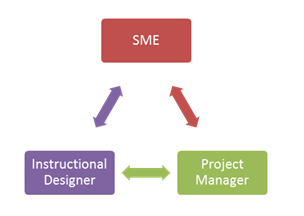The Autonomy of E-learning Curriculum -A 6 Step Process

E-learning has made training easy and fun for the learners – facilitates learning at their own pace and on any device or anywhere on a click. It is a great boon for training managers and trainers as well. You need to create a course once and reduce classroom training costs. Primarily travel costs and the burden of the trainer to train endless times different sets of audience can be avoided.
As organizations see the benefit of training their employees through eLearning, now they are venturing to develop an entire curriculum. These eLearning curriculums are used as a blended approach in combination with classroom training and sometimes as standalone eLearning modules.
Today we will see how to effectively create eLearning curriculums and maintain then for long-term use.
Step 1: Need Analysis
Based on the organizational goals of the organization and the skills set of the employees, we have to come up with detailed training needs. This exercise will help us decide the specific trainings that need to be done in order to enhance the knowledge and skills of the employees.
For example, let us assume that a manufacturing organization has strategically decided to recruit 10,000 employees worldwide in order to launch 10 new products. This will mean that there would be a huge training need to train new hires on the various aspects of business – organization culture and hierarchy, product training, process training, compliance training.
Step 2: Curriculum Scope
Based on the training needs, we need to make a decision on the following three aspects:
- List of curriculum and trainers. We should also prioritize the curriculums based on the need.
- Decide the delivery method – Will it be standalone eLearning or blended with classroom? If it is blended with classroom, will it be prior to classroom training or post classroom?
- A decision needs to be made at the start, if these courses need to be translated into multiple languages.
Once the trainers for the curriculum are identified, they need to break each curriculum into lessons. We should make sure that each lesson is a 20-minute eLearning module.
Example of a Curriculum Scope:
| Curriculum | Marketing |
| LEVELS | Lessons |
| BASIC |
|
| INTERMEDIATE |
|
| ADVANCED |
|
Step 3: Content Acquisition
The first two steps are more at a strategic level. Once these two are done well, then the Content acquisition step becomes easier. Organizations have plenty of content on most of the subjects in terms of PowerPoint presentations, instructor notes, manuals, etc.
These materials need to be sourced and kept at one location. It is important to have the Project Manager, Subject Matter Expert and Instructional Designer to work closely.
We will be able to develop the right content if we follow these three steps.
- Create learning outcomes of the course
- Develop content outline based on the outcomes
- Collect relevant content based on the outline. If content is readily available, SMEs start developing the content based on the learning outcome and the content outline.
Step 4: Developing Instructional Approach
Now you have all the content available in its raw form; the Instructional designer along with the SMEs should develop an instructional design approach across the curriculum.
- How should the course be presented to the leaner?
- What learning aids will be provided?
- How should the process and flow be presented?
- How can we make learning effective even if a trainer is not available?
- How should the learning be evaluated?
Examples of Instructional Strategy:
- Ice Breaker- Teaser questions to evaluate prior knowledge on the subject
- Situational story-telling approach using avatars
- Imparting knowledge through infographics, click on tabs, click on process flow
- Examples and case study to reinforce key take away points.
- Formative assessments through interactive quiz and summative assessment with a formal quiz at the end
- Glossary, references (PDFs), and job aids
Step 5: Designing eLearning Development Kit
Now that we are aware of how we need to create the course, we should develop a functional development kit that contains the GUI and templates for all the strategies discussed. If this step is done well and signed off with the SMEs, we can scale up the curriculum development. Here we need visual designers and instructional designers to work on the functional development kit.
- Decide the authoring tool based on the curriculum scope
- Visual presentation of the user interface and features within the course
- Designing each learning pattern – click on tabs, process flow, examples, case studies etc.
- Making then functional using the authoring tool selected.
Step 6: Scripting and Designing the Course Using Authoring Tools
The final step of developing eLearning curriculum is scripting each screen and designing it in the authoring tool using the set learning patterns.
Some best practices of scripting an eLearning course.
- Start with defining learning outcomes
- Use a conversational tone to make learning effective
- Add appropriate graphics and visuals
- Involve the learner at regular intervals to build interactivity
- Evaluate learners’ progress with assessments and feedback
- Reinforce learning by summarizing
- Conclude with a final quiz
Once your eLearning curriculum is developed, you have great autonomy of imparting training to your learners at any place, any time and now using any device. It is a best training investment for many years to come. All you need is revisit the curriculum once a year and update it.
Hope you found this blog useful.



![Authoring Tools – The Secret Behind Rapid eLearning Solutions [Infographic]](https://blog.commlabindia.com/hubfs/Imported_Blog_Media/authoring-tools-rapid-elearning-solutions-infographic-v2.png)
![6 Quick Tips to Make Your Custom E-learning Courses Learner-Centric [Infographic]](https://blog.commlabindia.com/hubfs/Imported_Blog_Media/custom-elearning-advantages-1-1.jpg)
![An eLearning Trend for 2019: The Convergence of the Classroom and eLearning [Infographic]](https://blog.commlabindia.com/hubfs/Imported_Blog_Media/blended-learning-elearning-trend-infographic.jpg)